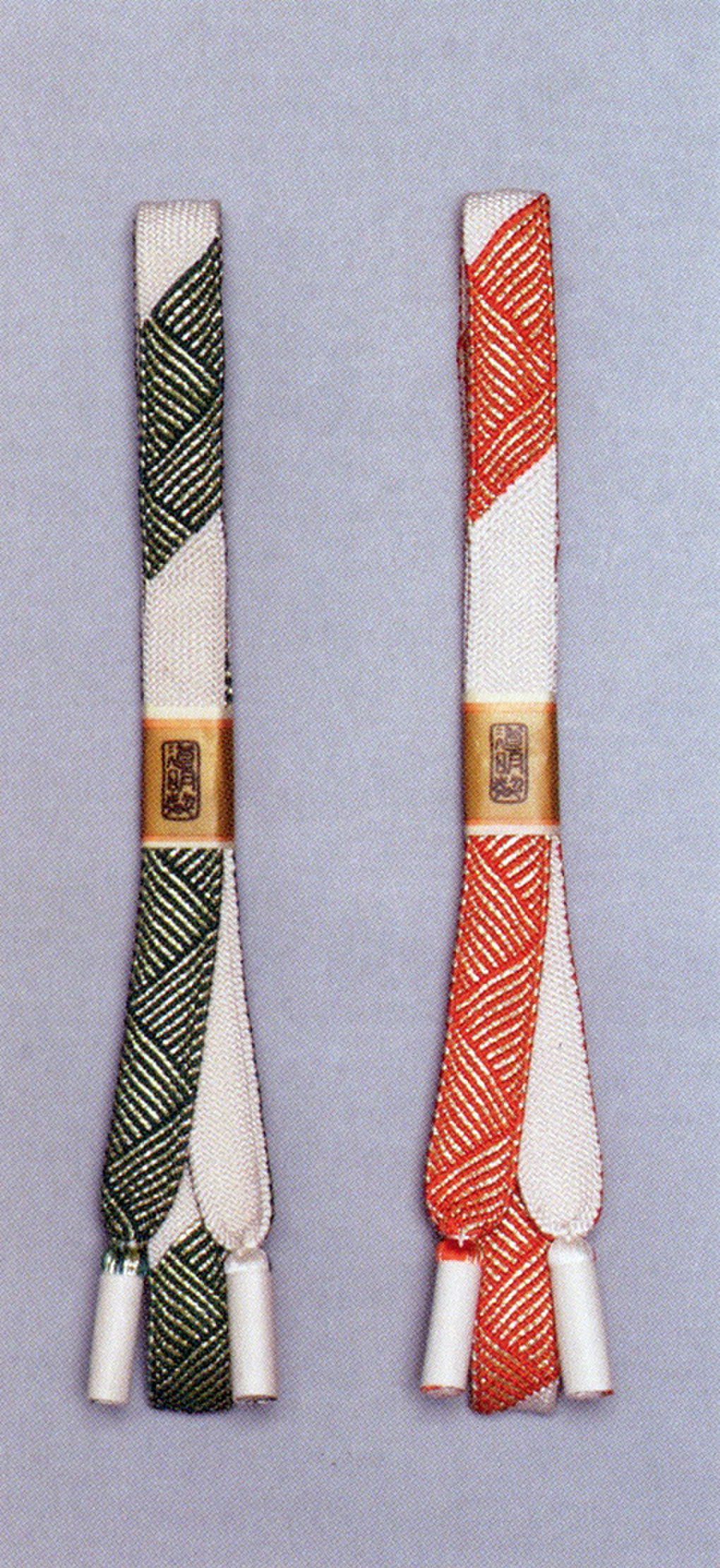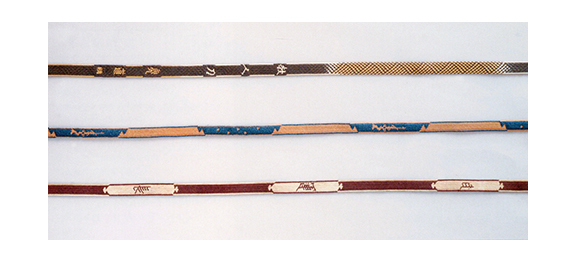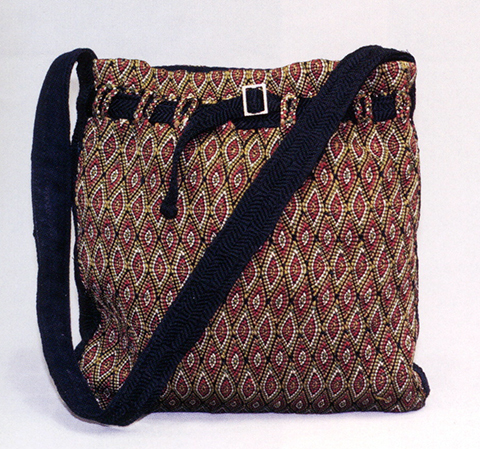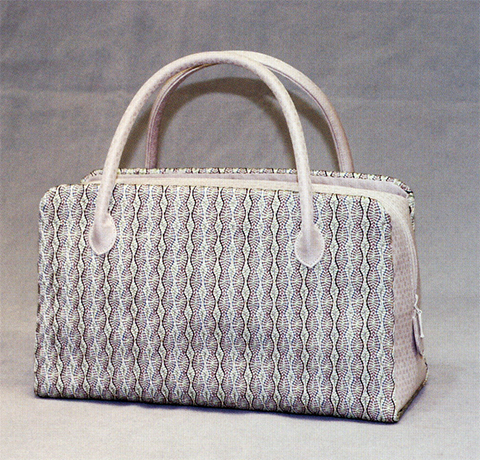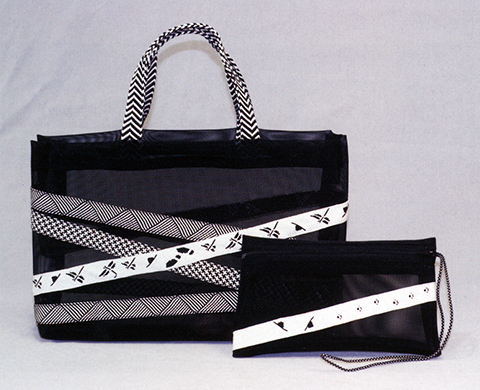About braiding and dyeing
Q: What are characteristics of Japanese Kumihimo?
The most characteristic one is the complexity of braiding methods. Those methods were introduced into Japan in the Nara Period, and have increasingly been sophisticated and complicated. The point is that how very complex pieces of Kumihimo are braided, including those procedures.
Q: What are differences among braiding methods?
They are differences of the number of threads, silk balls and how to move the balls. 10 to 40 threads are bundled and attached to one ball. The more the number of threads, the larger the sizes are. Kumihimo can be freely scaled. For example, if four threads are attached to a ball, thin Kumihimo is braided, and in case of 40 treads, 10 times thicker one.
Q: What is the difference between Kumihimo and textiles?
Their braiding methods are fairly different. I think rare methods are used for Japanese Kumihimo. For textiles, weft threads are inserted against warp threads. For Kumihimo, all threads are diagonally braided and folded at edges in a zig-zag manner. In addition to that, threads for textiles are thin, but for Kumihimo, about 10 threads are bundled, making it three-dimensional.
Q: What are the differences among braiding methods, such as Hiragumi and Kakugumi?
Generally, a different tool is used for each braiding method. Kakugumi is braided on Marudai, and flat and wide one on Takadai.
Q: Are traditional braiding methods and color matching methods are preserved?
As to braiding methods, many traditional methods are still used. Speaking of design, we have productized combinations of colors and braiding methods that have been used since the Edo Period. For example, patterns that are diagonally altered, such as the Seikaiha pattern, which represents wave crest patterns, are made by Edo style braiding methods. There are also other styles, such as Ayadashi, in which patterns are depicted like paintings. These patterns were developed in the Edo Period. (continued in the lower column)

Q: I have an impression that hexagonal patterns are usually used in Kumihimo.
Hexagonal patterns are popular when Kumihimo is used in occasions such as formal events and wedding ceremonies. A hexagonal pattern is one of the representative patterns.
Q: Are there some routines in which threads are bundled when braiding Kumihimo?
Those routines are carried out according to uses, desired widths and sizes. Kumihimo can be braided using both even- and odd-numbered threads. However, since threads are bundled by rotating several frames, there are the number of threads that are easy to use when making Kumihimo. For example, if a twisted thread made from four threads is bundled, multiples of four are better.
Q: What kind of dyeing methods are there?
There are dyeing methods in which threads are dyed with the same color from beginning to end while, in other methods, threads are dyed with different colors in the middle, which are called "Danzome." For example, threads are dyed cinnabar after some portions of the threads are protected against dyeing. After doing that, parts of them are protected against dyeing again, and then they are dyed pale blue.
Q: What kind of dye are you using?
For regular products, we have used acid dyes since prewar periods. Natural dyes do not have high weather resistance, and bleed into obi bands. We have dyed threads with traditional colors that fit in well with Japanese dresses. In case of restorations of old Kumihimo, customers might specify herb dyeing or natural dyes.
Q: Do traditional colors called "Edo no Koshoku," or old colors of Edo, have origins?
Well, for "Kihada" and "Suo," both of which are natural dyes, the name of dyes became color names.
Q: I think, in the past, color matching was different depending on occupations. Is there still such a custom?
You are talking about colors ordered for particular occupations, aren't you? It may be the case. For the tea ceremony, colors are different depending on sects. People freely coordinate colors for kimono, but there are some requests to not to use gold threads.
About Kumihimo as sash bands
Q: Has Kumihimo been used as sash bands since the Edo Period?
Kumihimo began to be used as sash bands since the end of the Meiji Period. Before that, it was used for sword straps. I think gold threads began to be inserted into Kumihimo after women started to use it as sash bands.
So its history as sash bands is about 100 years. At first, it was made with the same length and width as sword straps. I think, when the law banning the wearing of swords was enforced and there was no person who wore swords, they found a way to use sword straps as sash bands. Therefore, sizes of sword straps were applied to sash bands.
Q: Do colors of sash bands differ depending on age groups?
Some people order sash bands for a coming-of-age ceremony. Colors of them tend to be bright and flamboyant, which are suitable for young people, and gradually become subdued as wearers get older. As with kimono, people change color matching according to age. However, people now tend to choose brighter colors than they used to be, which are similar to those of Western clothes.
Q: Do customers request particular design and width/length of sash bands when they purchase them?
It seems that customers do not pay too much attention to traditional braiding methods. It depends on how they match colors and patterns to their obi. Well, although they choose width and length according to their preferences, generally, the length is about 150cm, which is called "Nami Shaku." (continued in the right column)
Q: Do you use cm or "shaku" and "sun" as units of measurement when making Kumihimo?
We use shaku and sun. A sash band is Nami Shaku that is 4 shaku 8 sun 5 bu.
Q: How about when ordering and selling?
Although we use shaku and sun when measuring threads, cm is sometimes used according to customers' orders. We are familiar with shaku and sun within the company, and do not have problem with them, but we use cm following the goods quality labeling act when selling Kumihimo.
About Yusoku Kumihimo Domyo
Q: What does "Yusoku," which is used for the company name, mean?
Yusoku is usually used for "Yusoku Orimono," and means "well versed." We use it as an implication that we have knowledge of classics. We bear in mind that we should delve into Kumihimo in old times, including the Nara, Heian, Kamakura and Muromachi Periods, and create new Kumihimo products based on classics.
Q: Do you make all pieces of Kumihimo by hand?
Except particular thin pieces of Kumihimo, we make 99% of them by hand. We employ about 100 professional craftspersons, so approximately 800 Kumihimo products are now produced per month.
Some are hereditary craftspersons, and others are newcomers who have been taught by us. Our employees or craftspersons have taught them how to braid threads. Each one makes one or two types of Kumihimo after practicing how to make it and being taught braiding methods that are unique to us. He/she makes about one Kumihimo product on Marudai in a day or one on Takadai in two days. Some of them make as many as 20 Kumihimo products a month.
Q: Are there many craftswomen? Are some of them young?
Most of them are women. They are in their 30s or later. Many of them are around 50 years old. We have tried to invite young people to work with us.
Q: Generally, furniture and family Buddhist altars are made by dividing work processes. How about Kumihimo?
Basically, we get in refined and twisted silk threads, and then carry out subsequent processes by ourselves. We dye and measure silk threads, and then hand them over to craftspersons. At the end, we finish Kumihimo products, so we produce and sell them by ourselves.
Q: Who design Kumihimo products?
We design Kumihimo products internally. After anticipating how those products are completed, we dye and measure silk threads.
Q: Could you tell me about recent product developments?
We try to create Kumihimo products for Western dresses, including neckties, bow ties, brooches and accessories while still making traditional sash bands. People prefer colors that are different from those of Japanese dresses.
Q: Is there overseas demand?
Although most customers who buy sash bands are Japanese, these neckties and bow ties are also very popular among foreign tourists, so we consider to promote those products overseas.
About an exhibition of Domyo Kumihimo
Q: Do you annually hold an exhibition of the Kumihimo class?
As to the Kumihimo class, we rent a big hall in Ginza and hold an exhibition of works titled "Domyo-ten" at the end of every April.
Q: Is it an exhibition of works by students who have studied Kumihimo at the class?
Basically, works created by students are exhibited. It is the 45th exhibition this year. The class itself has been held for about 50 years, and now approximately 400 students are enrolled in the class. Some students have studied Kumihimo for a long time and can braid wider range of products than professional craftspersons, so there are some students who became Kumihimo researchers.
Q: Are there foreign students?
Now there is no foreign student, but some foreigners studied Kumihimo in the past. Some of them have opened Kumihimo classes after returning home.
Q: Do you occasionally make unique works other than sash bands?
Although most works are sash bands, we sometimes make a variety of works. This is a pamphlet of our works. These bags are made by tying pieces of Kumihimo together, so it took an incredibly long time to make them.
Q: Do you occasionally adopt new things, such as Western patterns?
Well, we have a rule that students should design Kumihimo products by themselves, so they come up with a variety of new ideas.
Those ideas vary in patterns and colors. There are both Japanese traditional colors and Western colors based on Western paintings.
Works that won an award for excellence at "Dento no Kumihimo," the 41st exhibition of Domyo Kumihimo
Kumihimo on themes of Western paintings

Kumihimo products in the motif of "Water Lilies" by Monet

Kumihimo products in the motif of "The Red Studio" by Matisse

Kumihimo products in the motif of "Fruit Dish" by Braque
Kumihimo on themes of Western paintings

Kumihimo products in the motif of "Water Lilies" by Monet

Kumihimo products in the motif of "The Red Studio" by Matisse

Kumihimo products in the motif of "Fruit Dish" by Braque













